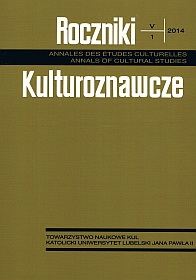The Knowledge about Culture as the Knowledge about Art: Selected Issues Related to Research on Art
Abstract
The knowledge about art in the context of the knowledge about culture, since the earliest methodological findings, has remained in the realm of creating the description system, creating the appropriate notions and names, which reflect the form of a work of art and constitute the basis of research on content. Works of plastic arts and architecture demanded research on cultural milieus where they were created because of the sponsorship of their founder and recipient. Historical research formed the basis for creating the first systems putting in order different kinds of art, chronologies within countries, regions and specific authors. The creation of the language describing works of art was combined with research on religious language and with technique and technology of works of art. Natural science, chemistry and optics supported the development of scientific basis of the conservation of works of art which is indispensable in the research process and in museology.
The knowledge about art was also an introduction to the realm of the knowledge about culture, defined as a history of spirit by the renowned researchers of the beginning of the 20th century such as M. Dvorak and F. Saxl, or as a symbolic form for which the philosophical bases were formulated by E. Cassirer, and for plastic arts the bases were developed by E. Panofsky. The history of culture and the history of art and literature revealed the values of religious and social culture pointing out the contents incorporated into works of art. The form, correctly defined in its description, found out in research of art its affinity with other fields of culture, religious and social life as well as references to a specific group of recipients defined as an elite or popular group, which was identified with a folk one.
In works of art and, similarly, in manifestations of culture, human psychological condition, human emotions, fascinations and widely understood psychology of creation and its reception were discovered. The interpretation defined by A. Riegl as Kunstwollen was continued by other researchers, such as E. Gombrich. In the most recent research it regains its place in widely understood anthropology of art.
Within the realm of modern research on art and culture a distinct trend of research appeared covering the culture and art of European regions and specific geographical areas, which, blending with wide trends in culture, express their own features belonging to the culture and tradition of a region.
References
Baxandall M.: Pittura ed esperienze sociali nell’ Italia del Quattrocento. Torino: Einaudi 1978.
Belting H.: Kunstgeschichte aber wie? Berlin 1978.
Białostocki J.: Erwin Panofsky – myśliciel, historyk, człowiek. W: Tenże. Refleksje i syntezy ze świata sztuki. Warszawa: PWN 1978 s. 304-342.
Burke P.: Świat na opak. Rozważania o kulturze ludowej. W: Europa i świat w początkach epoki nowożytnej. Cz. 1: Społeczeństwo, kultura, ekspansja. Red. A. Mączak. Warszawa: Wiedza Powszechna 1991 s. 79.
Cassirer E.: Esej o człowieku. Wstęp do filozofii kultury. Przeł. A. Staniewska. Przedmowa B. Suchodolski. Warszawa: Czytelnik 1998.
Cassirer E.: Philosophie der symbolischen Formen. Bd. I-III. Berlin: B. Cassirer 1923-1929.
Derrida J.: Struktura, znak i gra w dyskursie nauk humanistycznych. „Pamiętnik Literacki” 77:1986 z. 2 s. 252-253.
Fiorillo J.D.: Geschichte der zeichnenden Künste. Göttingen 1798.
Foucault M.: Archeologia wiedzy. Przekład i oprac. A. Siemek. Warszawa: De Agostini Polska 2002.
Francastel P.: L’ Arte e la civiltà moderna. Milano: E. Feltrinelli 1959.
Francastel P.: Twórczość malarska a społeczeństwo. Przeł. J. Karbowska, A. Szczepańska, J. Starzyński. Warszawa: PIW 1973.
Kiereś H.: Czy sztuka jest autonomiczna? W związku z tzw. antysztuką. Lublin: RW KUL 1993.
Kierkus-Prus M.: Eksploracja marginesów? Próba zastosowania elementów dekonstrukcji w badaniach średniowiecznej nastawy ołtarzowej. W: Historia sztuki po Derridzie. Materiały seminarium z zakresu teorii historii sztuki. Rogalin, kwiecień 2004 r. Red. Ł. Kiepuszewski. Poznań: Wyd. Naukowe UAM 2006 s. 34-45.
Lanzi L.: Storia pittorica dell Italia. Bassano 1789.
Lipski A.: Sztuka a rzeczywistość potocznego doświadczenia. Świat artystyczny jako przedmiot analizy socjologicznej. W: Tenże, K. Łęcki, Perspektywy socjologii kultury artystycznej. Warszawa: Wyd. naukowe PWN 1992 s. 9.
Max Dvořák i jego teoria dziejów sztuki. Wybór i posłowie L. Kalinowski. Warszawa: PWN 1974 s. 566-567.
Nycz R.: O jednym z powodów tak zwanego kryzysu (w humanistyce, zwłaszcza polonistycznej). „Teksty Drugie” 2001 nr 1(66) s. 4-6.
Panofsky E.: Die Perspektive als „symbolische Form“. W: Aufsätze zu Grundfragen der Kunstwissenschaft. Hrsg. H. Oberer, E. Verheyen. Berlin: B. Hessling 1964.
Panofsky E.: Die Renaissancen der europäischen Kunst. Frankfurt am Main: Suhrkamp 1979.
Panofsky E.: Idea. Ein Beitrag zur Begriffsgeschichte der älteren Kunsttheorie. Leipzig–Berlin: B.G. Teubner 1924.
Panofsky E.: Über das Verhältnis der Kunstgeschichte zur Kunsttheorie. „Zeitschrift für Ästhetik und allgemeine Kunstwissenschaft” 18:1925 s. 129-161.
Piwocki K.: Pierwsza nowoczesna teoria sztuki. Poglądy Aloisa Riegla. Warszawa: PWN 1970.
Popper K.R.: Nędza historyzmu. Przeł. S. Amsterdamski. Warszawa: Wyd. Naukowe PWN 1999.
Saxl F.: Po co nam historia sztuki. W: Pojęcia, problemy, metody współczesnej nauki o sztuce. Dwadzieścia sześć artykułów uczonych europejskich i amerykańskich. Wybrał, przekłady przejrzał, wstępem opatrzył J. Białostocki. Warszawa: PWN 1976 s. 25.
Seroux D’Agincourt J.B.: Histoire de l’art les monuments. Paris 1811-1823.
Skubiszewski P.: Dzieło sztuki a źródło historyczne. W: Proces historyczny w literaturze i sztuce. Materiały konferencji naukowej. Instytut Badań Literackich 1965. Red. M. Janion, A. Kmita-Piorunowa. Warszawa: PIW 1967 s. 281-288.
Strzelczyk J.: Historia powszechna. Średniowiecze. Poznań: Wyd. Poznańskie 2008.
Tatarkiewicz W.: O filozofii i sztuce w setną rocznicę urodzin. Warszawa: PWN 1986.
Warburg A.: Italienische Kunst und internationale Astrologie im Palazzo Schifanoia. W: Italia e l’arte straniera. Atti del X Congresso Internazionale di Storia dell’Arte in Roma. Roma: Maglione & Strini 1922 s. 179-193.
Winckelmann J.J.: Geschichte der Kunst des Altertums. Drezno 1764.
Wölfflin H.: Gedanken zur Kunstgeschichte. Wien 1940.
Wölfflin H.: Podstawowe pojęcia historii sztuki. Problem rozwoju stylu w sztuce nowożytnej. Przeł. D. Hulanka. Wrocław–Warszawa–Kraków: Ossolineum 1962 (tytuł oryginału: Kunstgeschichtliche Grundbegriffe. Das Problem der Stilentwicklung in der neueren Kunst. München: F. Bruckmann 1915).





